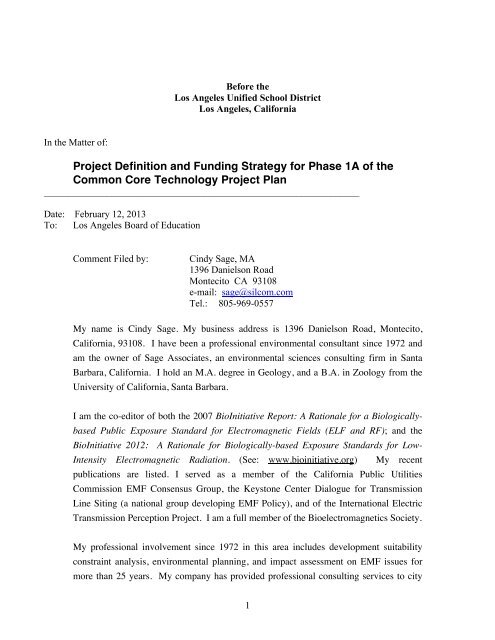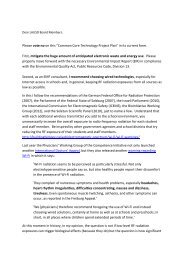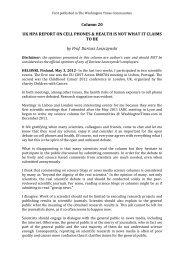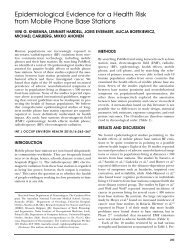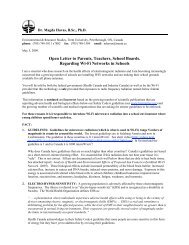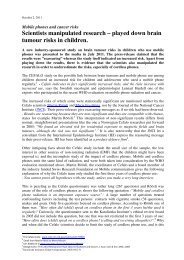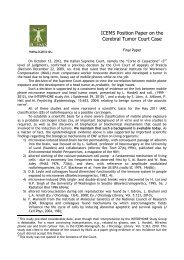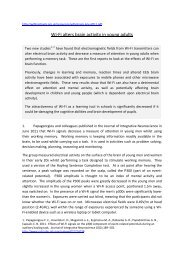Cindy Sage Letter to LAUSD - Electromagnetic Health
Cindy Sage Letter to LAUSD - Electromagnetic Health
Cindy Sage Letter to LAUSD - Electromagnetic Health
You also want an ePaper? Increase the reach of your titles
YUMPU automatically turns print PDFs into web optimized ePapers that Google loves.
In the Matter of:<br />
Before the<br />
Los Angeles Unified School District<br />
Los Angeles, California<br />
Project Definition and Funding Strategy for Phase 1A of the<br />
Common Core Technology Project Plan<br />
_________________________________________________________________<br />
Date: February 12, 2013<br />
To: Los Angeles Board of Education<br />
Comment Filed by: <strong>Cindy</strong> <strong>Sage</strong>, MA<br />
1396 Danielson Road<br />
Monteci<strong>to</strong> CA 93108<br />
e-mail: sage@silcom.com<br />
Tel.: 805-969-0557<br />
My name is <strong>Cindy</strong> <strong>Sage</strong>. My business address is 1396 Danielson Road, Monteci<strong>to</strong>,<br />
California, 93108. I have been a professional environmental consultant since 1972 and<br />
am the owner of <strong>Sage</strong> Associates, an environmental sciences consulting firm in Santa<br />
Barbara, California. I hold an M.A. degree in Geology, and a B.A. in Zoology from the<br />
University of California, Santa Barbara.<br />
I am the co-edi<strong>to</strong>r of both the 2007 BioInitiative Report: A Rationale for a Biologically-<br />
based Public Exposure Standard for <strong>Electromagnetic</strong> Fields (ELF and RF); and the<br />
BioInitiative 2012: A Rationale for Biologically-based Exposure Standards for Low-<br />
Intensity <strong>Electromagnetic</strong> Radiation. (See: www.bioinitiative.org) My recent<br />
publications are listed. I served as a member of the California Public Utilities<br />
Commission EMF Consensus Group, the Keys<strong>to</strong>ne Center Dialogue for Transmission<br />
Line Siting (a national group developing EMF Policy), and of the International Electric<br />
Transmission Perception Project. I am a full member of the Bioelectromagnetics Society.<br />
My professional involvement since 1972 in this area includes development suitability<br />
constraint analysis, environmental planning, and impact assessment on EMF issues for<br />
more than 25 years. My company has provided professional consulting services <strong>to</strong> city<br />
1
and county planners, private developers, state agencies including the California<br />
Department of Education School Facilities Siting Division, the Inglewood School District<br />
(La Tijera and Highland elementary schools), Anaheim, Las Virgenes Unified, Long<br />
Beach and Fairfield-Suisun School Districts and Fontana and Lawndale elementary<br />
schools with respect <strong>to</strong> measurement and assessment of electromagnetic fields (EMF) and<br />
radiofrequency radiation (RFR). I provided electromagnetic field (EMF) technical<br />
assistance under contract <strong>to</strong> the California Department of Education School Facilities<br />
Planning Division for transmission line siting setbacks and EMF policy. It include<br />
development of a new EMF Policy Variance and procedures <strong>to</strong> implement the policy,<br />
and preparation of a Guide <strong>to</strong> Architects and Electrical Engineers on Low-EMF Design<br />
and Building. I have been an expert witness on EMF policy, public perception,<br />
transmisson line impacts and land use issues, and have qualified both in state and in<br />
federal court proceedings as an expert witness in this area.<br />
RECOMMENDED ACTION:<br />
It is my professional opinion the <strong>LAUSD</strong> should implement Common Core Technology<br />
goals <strong>to</strong> ‘reduce the Digital Divide’ and <strong>to</strong> provide all <strong>LAUSD</strong> students with 21 st century<br />
learning <strong>to</strong>ols and environments by choosing wired (cable, fiber optic) methods rather<br />
than wireless technology systems. The <strong>LAUSD</strong> will place hundreds of thousands of<br />
school children at risk for illness, learning impairments and other health problems by<br />
choosing a delivery technology that produces a <strong>to</strong>xic emission (radiofrequency and<br />
microwave radiation) that has recently been classified as a Possible Human Carcinogen.<br />
It is in the best interest of the District, its Board, and the children, teachers and staff the<br />
District protects <strong>to</strong> provide healthy and safe school environments. These interests are<br />
best served if the District takes account of clear evidence of possible wireless health<br />
risks, and rejects the proposed program for wireless classrooms within the Los Angeles<br />
Unified School District. Failing <strong>to</strong> select wired over wireless technologies will<br />
needlessly expose hundreds of thousands of school children, as well as faculty and staff<br />
of <strong>LAUSD</strong> <strong>to</strong> massive new and unnecessary RFR exposures that are already designated<br />
as a Possible Human Carcinogen. The <strong>LAUSD</strong> should halt its current plan <strong>to</strong> provide<br />
wireless learning environments (wireless devices and WI-FI coverage). Instead, the<br />
Board should adopt programs <strong>to</strong> expand wired internet infrastructure and “EMF/RFR best<br />
practices” including the use of wired (CAT-6 or other), cable modem internet, or fiber<br />
optic connections instead that do not produce <strong>to</strong>xic exposures.<br />
2
RATIONALE<br />
1. Children are known <strong>to</strong> be more vulnerable <strong>to</strong> environmental <strong>to</strong>xins and carcinogens<br />
than adults. There is overwhelming evidence that children are more vulnerable than<br />
adults <strong>to</strong> many different exposures (Sly and Carpenter, 2012), including RFR (Wiart et al,<br />
2008), and that the diseases of greatest concern are cancer and adverse effects on<br />
neurodevelopment. The <strong>LAUSD</strong> has a duty <strong>to</strong> protect the health and welfare of children,<br />
teachers, staff, students and disabled individuals on all campuses. Children, teachers and<br />
the disabled cannot remove themselves from potentially harmful wireless exposures if the<br />
<strong>LAUSD</strong> adopts programs for all-wireless classrooms and learning environments in the<br />
District.<br />
Prenatal and post-natal exposure <strong>to</strong> cell phone radiation has been reported <strong>to</strong> cause<br />
headaches and migraines in a study of Danish children at age seven (7). In The Open<br />
Pediatric Medicine Journal (2012), a report by Sudan et al. has found an association<br />
between mothers’ reports of prenatal and postnatal cell phone exposures and headaches,<br />
including migraines in seven year-old children. Children with both prenatal and post-<br />
natal exposure <strong>to</strong> cell phones had a thirty (30) percent higher risk for migraines and other<br />
headache-related symp<strong>to</strong>ms. Since both pregnant women on staff and in teaching<br />
positions, as well as elementary school children will be exposed <strong>to</strong> cell phone radiation<br />
from wireless device use, the <strong>LAUSD</strong> should be strongly cautioned about introducing<br />
pervasive wireless RFR exposures in schools. This study provides support for an earlier<br />
evaluation of cell phone radiation effects by members of the same research team on the<br />
same Danish population of mothers and children. In 2008, this research team reported<br />
that maternal use of a cell phone resulted in behavioral and learning difficulties in the<br />
child by elementary school age (Divan et al, 2008).<br />
2. Existing FCC safety standards are under formal review by the FCC (Proceeding 03-<br />
137). The US Government Accountability Office Report of 2012 recommends <strong>to</strong> the<br />
FCC that it formally reassess, and, if appropriate, change it's current RF energy exposure<br />
limit and mobile phone testing requirements related <strong>to</strong> likely usage configurations,<br />
particularly when phones are held against the body (US GAO, 2012). The existing FCC<br />
public safety standards cannot be presumed for purposes of the <strong>LAUSD</strong> decision on<br />
wireless <strong>to</strong> be protective of public health under these circumstances. The existing safety<br />
limits do not protect against chronic exposures nor against non-thermal effects of<br />
3
adiofrequency and microwave radiation on human health. They are specifically not<br />
protective of children or smaller-stature individuals (they are developed <strong>to</strong> be suitable <strong>to</strong><br />
protect a six-foot man (in stature). They address acute, but not chronic exposures. And<br />
they are not protective against biological effects of non-thermal low-intensity RFR<br />
exposures for either children, adults, or the disabled. Biological effects of EMF and<br />
RFR are considered scientifically established; and can reasonably be presumed <strong>to</strong> result<br />
in health harm with long-term exposure of the kind under consideration by <strong>LAUSD</strong> with<br />
wireless classrooms.<br />
3. <strong>LAUSD</strong> must incorporate appropriate measures <strong>to</strong> address the recent World <strong>Health</strong><br />
Organization International Agency for Research on Cancer (IARC) classification of RFR<br />
as a Possible Human Carcinogen before subjecting widespread hundreds of thousands of<br />
its District personnel and students <strong>to</strong> a preventable <strong>to</strong>xic exposure. The WHO IARC<br />
classified RF radiation as a Group 2B Possible Human Carcinogen; it joins the IARC<br />
classification of ELF-EMF (Extremely Low Frequency <strong>Electromagnetic</strong> Fields) as a<br />
Group 2B Possible Human Carcinogen. The evidence for carcinogenicity for RFR was<br />
primarily from cell phone/brain tumor studies but IARC applies this classification <strong>to</strong> all<br />
RFR exposures. <strong>LAUSD</strong> has been responsive <strong>to</strong> the need <strong>to</strong> reduce risks from chemicals<br />
in the District. EMF and RFR exposures should be considered equally in decision-<br />
making. The combined effects of <strong>to</strong>xic agents (chemicals) and EMF/RFR are<br />
established. Juuilainen et al. (2006) reported that the combined effects of <strong>to</strong>xic agents and<br />
ELF magnetic fields <strong>to</strong>gether enhances damage as compared <strong>to</strong> the <strong>to</strong>xic exposure alone.<br />
In a meta-analysis of 65 studies; overall results showed 91% of the in vivo studies and<br />
68% of the in vitro studies had worse outcomes (were positive for changes indicating<br />
synergistic damage) with EMF/RFR exposure in combination with <strong>to</strong>xic agents<br />
(Juutilainen et al, 2006).<br />
4. Biologically-based public exposure safety regulations for low-intensity, chronic<br />
exposure <strong>to</strong> RFR (radiofrequency radiation) are absent – so there is no reasonable<br />
assumption by <strong>LAUSD</strong> that it can rely on outdated (1996) and highly contested FCC<br />
safety limits in this decision.<br />
5. No positive assertion of safety of wireless technologies in classroom environments can<br />
be made.<br />
4
6. The <strong>LAUSD</strong> has the obligation <strong>to</strong> ensure that all campuses under its jurisdiction are in<br />
compliance with existing law and that all classroom occupants are appropriately<br />
protected from any potential adverse effects from wireless RFR exposures. <strong>LAUSD</strong> is<br />
required by law <strong>to</strong> conduct a full risk assessment of all <strong>to</strong>xic exposures by State code and<br />
this <strong>to</strong>xic exposure is not exempt. The evidence in 2012 is greater than in 2007 that RFR<br />
is associated with increased risk for cancer and neurological diseases; immune disorders,<br />
altered fetal brain development in pregnant women; sleep disruption, and impaired<br />
cognition, memory, learning, attention, concentration, and behavior in school children.<br />
7. New scientific studies of radiofrequency radiation of the kind and at the levels<br />
associated with wireless classroom environments report that chronic, whole-body RFR<br />
exposure at levels as low as 0.003 microwatts per square centimeter result in adverse<br />
health effects on children and adolescents (Thomas et al 2008; Heinrich et al 2010;<br />
Thomas et al 2010; Mohler et al 2010). Wireless classrooms will create unavoidable and<br />
involuntary exposure <strong>to</strong> RFR at levels shown <strong>to</strong> adversely affect memory, learning,<br />
cognition, attention, concentration and behavior <strong>to</strong> school occupants. No level of RFR<br />
exposure has been conclusively determined <strong>to</strong> be safe.<br />
• Thomas et al (2008) reported an increase in adult complaints of headaches and concentration<br />
difficulties with short-term cell phone use at 0.005 <strong>to</strong> 0.04 μW/cm2 exposure levels.<br />
• Heinrich et al (2010) reported that children and adolescents (8-17 years old) with short-term<br />
exposure <strong>to</strong> base-station level RFR experienced headache, irritation, and concentration difficulties<br />
in school. RFR levels were 0.003 - 0.02 μW/cm2.<br />
• Thomas et al (2010) reported that RFR levels of 0.003 - 0.02 μW/cm2 resulted in conduct and<br />
behavioral problems in children and adolescents (8-17 years old) exposed <strong>to</strong> short-term cell<br />
phone radiation in school.<br />
• Mohler et al (2010) reported that adults exposed <strong>to</strong> 0.005 μW/cm2 cell phone radiation (basestation<br />
exposure levels) had sleep disturbances with chronic exposure, but this effect was not<br />
significantly increased across the entire population<br />
8. For <strong>LAUSD</strong> <strong>to</strong> disregard existing health warnings from international science and<br />
public health experts by intentionally introducing technologies already shown <strong>to</strong> degrade<br />
learning environments would be reckless. It will create unnecessary liability for the<br />
District and will waste hundreds of thousands of dollars when wireless must eventually<br />
5
e substituted out for wired alternatives. The <strong>LAUSD</strong> cannot afford <strong>to</strong> pay for wireless<br />
classrooms, only <strong>to</strong> have <strong>to</strong> replace them in short order with safer hard wired solutions<br />
that do not carry the burden of increased illness and District costs for health care and<br />
student remedial education.<br />
9. Alternatives exist for internet connectivity that are not detrimental <strong>to</strong> learning<br />
environments and healthy classrooms.<br />
10. A solid economic analysis is lacking <strong>to</strong> demonstrate that possible short-term<br />
economies of wireless are not, in the long run, far more expensive in relation <strong>to</strong> hard-<br />
wiring for internet connectivity. Such an economic analysis must consider all relevant<br />
costs for installation and maintenance; upgrades, health and safety costs, absentee losses,<br />
reduction in learning and increased special education needs; remediation costs, and the<br />
likely replacement of wireless for wired options as new public safety requirements must<br />
be met.<br />
11. <strong>LAUSD</strong> should not accept positive assurances of safety from wireless technology<br />
providers who will claim that there is ‘no proof’ of harm. Proof of health harm is not and<br />
should not be required by the <strong>LAUSD</strong> Board in order <strong>to</strong> make a choice for safer<br />
education. A standard of evidence that requires ‘proof of harm’ from wireless<br />
technologies should be rejected by the <strong>LAUSD</strong> Board as a basis for deciding the question<br />
of whether <strong>to</strong> proceed with wireless classrooms.<br />
12. There is more than sufficient evidence in hand <strong>to</strong>day <strong>to</strong> show that wireless exposures<br />
for children, teachers, staff and the disabled over the long-term is inadvisable; and<br />
possible risk exists leading <strong>to</strong> health harm and learning impairments. Short- term effects<br />
on cognition, memory and learning, behavior, reaction time, attention and concentration,<br />
and altered brainwave activity (altered EEG) are also reported in the scientific literature<br />
(Sections 6 and 9, BioInitiative 2012 Report). EMF and RFR exposures cause bioeffects<br />
and adverse health effects consistent with those identified in children with autism<br />
spectrum disorders (ASDs) (Section 20, BioInitiative 2012 Report).<br />
13. <strong>LAUSD</strong> should not encourage or mandate the use of wireless devices like iPads or<br />
wireless computers with associated wireless access points installed in classrooms; or cell<br />
phones in learning environments on <strong>LAUSD</strong> properties. There is evidence that is<br />
sufficient <strong>to</strong> warn against chronic use of wireless devices near or worn on the body<br />
6
ecause of adverse effects on the testes, on male sperm quality and fertility, and tissues<br />
related <strong>to</strong> reproductive organs in both males and females (See Footnote 1).<br />
14. In summary, <strong>LAUSD</strong> can achieve its educational goals by instituting new learning<br />
technologies for internet connectivity with hard-wired systems that do not create such<br />
preventable health risks. The goal of improving access <strong>to</strong> high-quality education and<br />
learning environments is best achieved by new infrastructure that is wired, not wireless.<br />
Any short-term economies that may seem attractive <strong>to</strong>day with wireless technologies are<br />
likely <strong>to</strong> be dwarfed by long-term health costs, learning achievement deficiencies,<br />
absenteeism and the eventual need <strong>to</strong> replace wireless with wired technological systems.<br />
Respectfully submitted this day of 12 February, 2013<br />
<strong>Cindy</strong> <strong>Sage</strong>, MA, <strong>Sage</strong> Associates<br />
Co-Edi<strong>to</strong>r, BioInitiative 2012 Report<br />
Co-Edi<strong>to</strong>r, BioInitiative 2007 Report<br />
Footnote 1 - Adverse effects are reported in more than 20 recent scientific studies on morphology and<br />
function of human male and female reproductive organs. Wireless devices that produce RFR exposure<br />
levels commonly associated with both ‘in-use’ and ‘on stand-by’ level ‘normal usage’ are associated with<br />
impairment of male reproductive organs (the testes), male hormone levels and sperm quality, motility and<br />
pathology. Wireless lap<strong>to</strong>ps and cell phones held close <strong>to</strong> the body are reported <strong>to</strong> negatively affect<br />
reproductive parameters in both human and animal studies (See Section 18 of the BioInitiative 2012 Report<br />
for references including Agarwal et al, 2008; Agarwal et al, 2009; Wdowiak et al, 2007; De Iuliis et al,<br />
2009; Fejes et al, 2005; Aitken et al, 2005; Kumar, 2012). Other studies conclude that exposure <strong>to</strong> cell RFR<br />
such as phone radiation, or s<strong>to</strong>rage of a mobile phone close <strong>to</strong> the testes of human males affect sperm<br />
counts, motility, viability and structure (Aitken et al, 2004; Agarwal et al, 2007; Erogul et al., 2006).<br />
Animal studies have demonstrated oxidative and DNA damage, pathological changes in the testes of<br />
animals, decreased sperm mobility and viability, and other measures of deleterious damage <strong>to</strong> the male<br />
germ line (Dasdag et al, 1999; Yan et al, 2007; Oti<strong>to</strong>loju et al, 2010; Salama et al, 2008; Behari et al, 2006;<br />
Kumar et al, 2012).. Panagopoulous et al. 2012 reported decreased ovarian development and size of<br />
ovaries, and premature cell death of ovarian follicles and nurse cells in Drosophila melanogaster. Gul et al<br />
(2009) report rats exposed <strong>to</strong> stand-by level RFR (phones on but not transmitting calls) caused decrease in<br />
the number of ovarian follicles in pups born <strong>to</strong> these exposed dams. Magras and Xenos (1997) reported<br />
irreversible infertility in mice after five (5) generations of exposure <strong>to</strong> RFR at cell phone <strong>to</strong>wer exposure<br />
levels of less than one microwatt per centimeter squared (µW/cm2)<br />
7
References<br />
Adey WR. Potential therapeutic applications of nonthermal electromagnetic fields:<br />
ensemble organization of cells in tissue as a fac<strong>to</strong>r in biological field sensing. In: Rosch<br />
PJ, Markov MS, edi<strong>to</strong>rs. Bioelectromagnetic Medicine, 2004.<br />
Aitken RJ, Koopman P, Lewis SEM. Seeds of concern. Nature 2004;432:48-52.<br />
Aitken RJ, Bennetts LE, Sawyer D, Wiklendt AM, King BV. Impact of radio frequency<br />
electromagnetic radiation on DNA integrity in the male germline. Int J Androl. 2005;<br />
28(3):171-179.<br />
Aldad TS, Gan G, Gao XB, Taylor HS. Fetal radiofrequency radiation exposure from<br />
800-1900 MHz-rated cellular telephones affects neurodevelopment and behavior in mice.<br />
Sci Rep. 2012;2:312.<br />
Agarwal A, Deepinder F, Sharma RK, Ranga G, Li J. Effect of cell phone usage on<br />
semen analysis in men attending infertility clinic: an observational study. Fertil Steril.<br />
2008; 89(1):124-128.<br />
Agarwal A, Desai NR, Makker K, Varghese A, Mouradi R, Sabanegh E, Sharma R.<br />
Effects of radiofrequency electromagnetic waves (RF-EMW) from cellular phones on<br />
human ejaculated semen: an in vitro pilot study. Fertil Steril. 2009;92(4):318-1325.<br />
Atasoy HI, Gunal MY, Atasoy P, Elgun S, Bugdayci G. Immunohis<strong>to</strong>pathologic<br />
demonstration of deleterious effects on growing rat testes of radiofrequency waves<br />
emitted from conventional Wi-Fi devices. J Pediatr Urol. 2012 [Epub ahead of print].<br />
Avendano C, Mata A, Sanchez Sarmien<strong>to</strong> CA, Doncei GF. Use of lap<strong>to</strong>p computers<br />
connected <strong>to</strong> internet through Wi-Fi decreases human sperm motility and increases sperm<br />
DNA fragmentation. Fertil Steril. 2012;97(1):39-45. Epub 2011 Nov 23.Environmental<br />
<strong>Health</strong> 2012,11:42 http://www.ehjournal.net/content/11/1/42 Behari J, Kesari KK. Effects<br />
of microwave radiations on reproductive system of male rats. Embryo Talk 2006;1<br />
(Suppl.1):81-5.<br />
Baan R, Lauby-Secretan B, El Ghissassi F, Bouvard V, Benbrahim-Tallaa, Guha N,<br />
Islami F, Galiecht L, Straif K, on behalf of the WHO International Agency for Research<br />
on Cancer Monograph Working Group. Carcinogenicity of Radiofrequency<br />
<strong>Electromagnetic</strong> Fields. Lancet Oncology, Published on line June 22, 2011,<br />
DOI:10.1016/S1470- 2045(11)70147-4<br />
Barouki R, Gluckmarn, PD, Grandjean P, Hanson M, Jeindel JJ. Developmental origins<br />
of non-communicable disease: Implications for research and public health.<br />
Bellieni CV, Acampa M, Maffei M, Maffei S, Perrone S, Pin<strong>to</strong> I, Stacchini N, Buonocore<br />
G. <strong>Electromagnetic</strong> fields produced by incuba<strong>to</strong>rs influence heart rate variability in<br />
newborns. Arch Dis Child Fetal Neonatal Ed. 2008;93(4):F298-301.<br />
8
Bellieni CV, Pin<strong>to</strong> I, Bogi A, Zoppetti N, Andreuccetti D, Buonocore G. Exposure <strong>to</strong><br />
electromagnetic fields from lap<strong>to</strong>p use of "lap<strong>to</strong>p" computers. Arch Environ Occup<br />
<strong>Health</strong>. 2012;67(1):31-36.<br />
Bellieni CV, Tei M, Iacoponi F, Tataranno ML, Negro S, Proietti F, Longini M, Perrone<br />
S, Buonocore G. Is newborn mela<strong>to</strong>nin production influenced by magnetic fields<br />
produced by incuba<strong>to</strong>rs?, Early Hum Dev 2012;88(8):707-710<br />
Belyaev IY, Alipov YD, Harms-Ringdahl M. Effects of zero magnetic field on the<br />
conformation of chromatin in human cells. Biochim Biophys Acta 1997;1336(3):465-<br />
473.<br />
Belyaev I. BioInitiative 2012 Update, Section 15. Role of physical and biological<br />
variables in bioeffects of non-thermal microwaves for reproducibility, Cancer Risk<br />
Assessment and Safety Standards, 2012.<br />
BioInitiative Working Group, <strong>Sage</strong> C, Carpenter DO, edi<strong>to</strong>rs. BioInitiative Report: A<br />
Rationale for a Biologically-based Public Exposure Standard for <strong>Electromagnetic</strong> Fields<br />
(ELF and RF) at www.bioinitiative.org, August 31, 2007.<br />
BioInititative Working Group, <strong>Sage</strong> C, Carpenter DO, edi<strong>to</strong>rs. BioInitiative 2012 Report:<br />
A Rationale for Biologically-based Public Exposure Standards for <strong>Electromagnetic</strong><br />
Radiation. December 31, 2012. www.bioinitiative.org<br />
Blank M, Goodman R. DNA is a fractal antenna in electromagnetic fields. Int. J. Rad.<br />
Biol. Early On-Line, 2011. 1-7. DOI: 10.3109/09553002.2011.538130<br />
Buchner K, Eger H. Changes of clinically important neurotransmitters under the<br />
influence of modulated RF fields—A long-term study under real-life conditions Umwelt-<br />
Medizin-Gesellschaft 2011;24(1):44-57. [Original study in German.]<br />
Buzsaki G. Rhythms of the brain. Oxford Press, 2006;464 pp.<br />
Carpenter DO <strong>Sage</strong> CL. 2008. Setting Prudent Public <strong>Health</strong> Policy for <strong>Electromagnetic</strong><br />
Field Exposures. Reviews on Environmental <strong>Health</strong> 23(2) 91-117.<br />
Carpenter DO. <strong>Electromagnetic</strong> fields and cancer: the cost of doing nothing. Reviews on<br />
Environmental <strong>Health</strong> 2010;25(1):75-80.<br />
Czyz J, Guan K, Zeng Q, Nikolova T, Meister A, Schönborn F, Schuderer J, Kuster N,<br />
Wobus AN. High frequency electromagnetic fields (GSM signals) affect gene expression<br />
levels in tumor suppressor p53-deficient embryonic stem cells. Bioelectromagnetics<br />
2004;25:296-307.<br />
9
Dasdag S. Whole-body microwave exposure emitted by cellular phones and testicular<br />
function of rats. Urological Research 1999;27(3):219-223.<br />
Davoudi M, Brossner C, Kuber W. The influence of electromagnetic waves on sperm<br />
motility. J Urol Urogynak 2002;29:19-22. De Iuliis GN, Newey RJ, King BV, Aitken RJ.<br />
Mobile phone radiation induces reactive oxygen species production and DNA damage in<br />
human sperma<strong>to</strong>zoa in vitro. PLoS One 2009;4(7):e6446.<br />
Divan HA. Kheifets L. Obel C. Olsen J. Prenatal and postnatal exposure <strong>to</strong> cell phone use<br />
and behavioral problems in children. Epidemiology 2008;19(4):523-529.<br />
Erogul O, Oztas E, YildirimI, Kir T, Aydur E, Komesli G, Irkilata HC, Irmak MK, Peker<br />
AF. Effects of electromagnetic radiation from a cellular phone on human sperm motility:<br />
an in vitro study Arch Med Res 2006;37:840-843.<br />
Falzone N, Huyser Cm, Becker P, Leszczynski D, Franken DR. The effect of pulsed 900-<br />
MHz GSM mobile phone radiation on the acrosome reaction, head morphometry and<br />
zona binding of human sperma<strong>to</strong>zoa. Int J Androl 2011;34:20-26.<br />
Fejes I, Zavaczki Z, Szollosi J, Koloszar S, Daru J, Kovacs L, Pal A. Is there a<br />
relationship between cell phone use and semen quality? Arch Androl 2005;51:385-393.<br />
Fragopoulou AF, Koussoulakos SL, Margaritis LH. Cranial and postcranial skeletal<br />
variations induced in mouse embryos by mobile phone radiation. Pathophysiology.<br />
2010;17(3):169-177.<br />
Fragopoulou AF, Miltiadous P, Stamatakis A, Stylianopoulou F, Koussoulakos SL,<br />
Margaritis LH. Whole body exposure with GSM 900MHz affects spatial memory in<br />
mice. Pathophysiology. 2010;17(3):179-187.<br />
Fragopoulou AF, Samara A, An<strong>to</strong>nelou MH, Xanthopoulou A, Papadopoulou A, Vougas<br />
K, Koutsogiannopoulou E, Anastasiadou E, Stravopodis DJ, Tsangaris GT, Margaritis<br />
LH. Brain proteome response following whole body exposure of mice <strong>to</strong> mobile phone or<br />
wireless DECT base radiation. Electromagn Biol Med. 2012 Jan 20. [Epub ahead of<br />
print]<br />
Fejes I, Zavaczki Z, Szollosi J, Koloszar S, Daru J, Kovacs L. Is there a relationship<br />
between cell phone use and semen quality? Arch. Androl. 2005;51:385-393.<br />
Gangi S, Johansson, O. A theoretical model based upon mast cells and histamine <strong>to</strong><br />
explain the recently proclaimed sensitivity <strong>to</strong> electric and/or magnetic fields in humans.<br />
Med Hypotheses 2000;54:663-671.<br />
Gee, D. Late Lessons from Early Warnings: Toward realism and precaution with EMF.<br />
Pathophysiology 2009;16(2,3):217-231.<br />
10
Gul A, Celebi H, Uğraş S. The effects of microwave emitted by cellular phones on<br />
ovarian follicles in rats. Arch Gynecol Obstet. 2009;280(5):729-733,<br />
Gutschi T Al-Ali MB Shamloul R Pummer K Trummer H. Impact of cell phone use on<br />
men’s semen parameters. Andrologia 2011;43(5):312-316.<br />
Hardell L <strong>Sage</strong> C. Biological effect from electromagnetic field exposure and public<br />
exposure standards. Biomedicine & Pharmacotherapy 2008;62:104-109.<br />
doi:10.1016/j.bipha.2007.12.004.<br />
Hardell et al, BioInitiative Report Update, Section 11, Use of wireless phones and<br />
evidence for increased risk of brain tumors, 2012.<br />
Heinrich S, Thomas S, Heumann C, von Kries R, Radon K. Association between<br />
exposure <strong>to</strong> radiofrequency electromagnetic fields assessed by dosimetry and acute<br />
symp<strong>to</strong>ms in children and adolescents: a population based cross-sectional study. Environ<br />
<strong>Health</strong> 2010;9:75.<br />
Hutter HP, Moshammer H, Wallner P. Kundi M. Subjective symp<strong>to</strong>ms, sleeping<br />
problems, and cognitive performance in subjects living near mobile phone base stations,<br />
Occup. Environ. Med. 2006;63:307-313.<br />
Interphone Study Group. Brain tumour risk in relation <strong>to</strong> mobile telephone use: results of<br />
the INTERPHONE international case-control study. International Journal of<br />
Epidemiology 2010;39(3):675-694.<br />
Johansson A, Nordin S, Heiden M, Sandstrom M. Symp<strong>to</strong>ms, personality traits, and<br />
stress in people with mobile phone-related symp<strong>to</strong>ms and electromagnetic<br />
hypersensitivity. J. Psychosom Res. 2010;68(1):37-45.<br />
Johansson O. Disturbance of the immune system by electromagnetic fields – a potentially<br />
underlying cause for cellular damage and tissue repair reduction which could lead <strong>to</strong><br />
disease and impairment. Pathophysiology 2009;16(2,3):157-177.<br />
Johansson O. Evidence for effects on the immune system – Section 8 in <strong>Sage</strong> C,<br />
Carpenter DO, edi<strong>to</strong>rs. BioInitiative Working Group, BioInitiative Report: A Rationale<br />
for a Biologically-based Public Exposure Standard for <strong>Electromagnetic</strong> Fields (ELF and<br />
RF) at www.bioinitiative.org, August 31, 2007.<br />
Juutilainen J Kumlin T Naarala J. 2006 Do extremely low frequency magnetic fields<br />
enhance the effects of environmental carcinogens? A meta-analysis of experimental<br />
studies. Ing J Radiat Biol 82: 1-12.<br />
Kheifets L Repacholi M Saunders R et al. The sensitivity of children <strong>to</strong> electromagnetic<br />
fields. Pediatrics 2005:116, 303-313.<br />
11
Kilgallon SJ, Simmons LW. Image content influences men’s semen quality. Biol Lett<br />
2005;1:253-255.<br />
Kundi M. Hutter HP. Mobile phone base stations—Effects on wellbeing and health.<br />
Pathophysiology 2009;16:123-135.<br />
Lai H. BioInitiative 2012 Report Update, Section 6, Geno<strong>to</strong>xicity, 2012.<br />
Landgrebe M, Hauser S, Langguth B, Frick U, Hajak G, Eichhammer P. Altered cortical<br />
excitability in subjectively electrosensitivie patients: results of a pilot study. J. Psychsom<br />
Res 2007; 62(3):283-288.<br />
Landgrebe M, Frick U, Hauser S, Langguth B Rosner R Hajak G, Eichhammer P.<br />
Cognitive and neurobiological alterations in electromagnetic hypersensitive patients:<br />
results of a case-control study. Psychol Med. 2008;38(12):1781-1791.<br />
Ponomarev V, Sandström M, Mild KH, Medvedev S. EEG Synchronization in man under<br />
influence of the modulated illumination. Human Physiology, 1995;21:6;38-41.<br />
Lyskov E, Ponomarev V, Sandström M, Mild KH, Medvedev S. Steady-state visual<br />
evoked potentials <strong>to</strong> computer moni<strong>to</strong>r flicker. Int Journal of Psychophysiology,<br />
1998;28:285-290.<br />
Lyskov. E, Sandström, M. Hansson Mild K. Neurophysiological study of patients with<br />
perceived electrical sensitivity. Int J Psychophysiol 2001;42, 233-241.<br />
Lyskov. E, Sandström, M. Hansson Mild K. Provocation study of persons with perceived<br />
electrical hypersensitivity and controls using magnetic field exposure and recording of<br />
electrophysiological characteristics. Bioelectromagnetics 2001;22:457-462.<br />
Magras, IN, Zenos TD, RF Radiation-induced changes in the prenatal development of<br />
mice. Bioelectromagnetics 1997;18:455-461.<br />
Marino A. Response <strong>to</strong> letter <strong>to</strong> the edi<strong>to</strong>r concerning ‘<strong>Electromagnetic</strong> Hypersensitivity:<br />
Evidence for a Novel Neurological Syndrome.” Int J Neurosci, Early On-line, 2012;1-2.<br />
Markova E. Malmgren LOG. Belyaev IY. Microwaves from mobile phones inhibit<br />
53PB1 focus formation in human stem cells stronger than in differentiated cells: Possible<br />
mechanistic link <strong>to</strong> cancer risk. Environmental <strong>Health</strong> Perspectives On-line 22 Oc<strong>to</strong>ber<br />
2009 doi:10.1289/ehp.0900781<br />
Markova E, Malmgrem LOG, Belyaev IY. Microwaves from mobile phones inhibit<br />
53PB1 focus formation in human stem cells stronger than in differentiated cells: possible<br />
mechanistic link <strong>to</strong> cancer risk. Environmental <strong>Health</strong> Perspectives 2010;118(3):394-399.<br />
McCarty DE, Carrubba S, Chesson AL, Frilot C, Gonzalez-Toledo E, Marino AA.<br />
12
<strong>Electromagnetic</strong> hypersensitivity: evidence for a novel neurological syndrome. Int J<br />
Neurosci 2011;121:670-676.<br />
Milham S. His<strong>to</strong>rical evidence that elecrrification caused the 20th century epidemic of<br />
“diseases of civilization”. Med Hypotheses 2010;74(2):337-345.<br />
Mohler E, Frei P, Braun-Fahrländer C, Fröhlich J, Neubauer G, Röösli M; Qualifex<br />
Team. Effects of everyday radiofrequency electromagnetic-field exposure on sleep<br />
quality: a cross-sectional study. Radiat Res 2010;174(3):347-356.<br />
Oberfeld G, Enrique NA. Manuel P, Ceferino M. Gomez-Perrretta C. The Microwave<br />
Syndrome – Further Aspects of a Spanish Study. 3rd International Workshop on<br />
Biological Effects of <strong>Electromagnetic</strong> Fields. Kos, Greece, 2004. .<br />
Oti<strong>to</strong>loju AA, Obe IA, Adewale OA, Otubanjo OA, Osunkalu VO. Preliminary study on<br />
the induction of sperm head abnormalities in mice, Mus musculus, exposed <strong>to</strong><br />
radiofrequency radiations from global system for mobile communication base stations.<br />
Bulletin of Environmental Contamination and Toxicology 2010;84(1):51-54.<br />
Navarro EA, Sequra J, Por<strong>to</strong>les M, Gomez-Perretta de Mateo C. The Microwave<br />
Syndrome: a preliminary study in Spain. Electromag Biol Med 2003;l22:161-169,<br />
Panagopoulos DJ. Effect of microwave exposure on the ovarian development of<br />
Drosophila melanogaster. Cell Biochem Biophys. 2012;63(2):121-132,.<br />
Presidents Cancer Panel. 2008-2009 Annual Report. Reducing Environmental Cancer<br />
Risk: What We Can Do Now, 2010.<br />
http://deainfo.nci.nih.gov/advisory/pcp/annualReports/pcp08-09rpt/PCP_Report_08<br />
09_508.pdf<br />
Pres<strong>to</strong>n RJ. Review: Children as a sensitive subpopulation for the risk assessment<br />
process. Toxicoloty and Applied Pharmacology 2004;199:132-141.<br />
<strong>Sage</strong> C, Carpenter DO. Public health implications of wireless technologies.<br />
Pathophysiology 2009;16:233-246.<br />
<strong>Sage</strong> C. Tragedy of the commons revisited: the high tech-high risk wireless world,<br />
Reviews on Environmental <strong>Health</strong> 2010;25(4):319-325.<br />
<strong>Sage</strong> C, Huttunen P. Guest Edi<strong>to</strong>rial. WHO recognizes electromagnetic dangers: let us<br />
declare human health rights. Pathophysiology 2012;19:1-3.<br />
<strong>Sage</strong> C Johansson O <strong>Sage</strong> SA. 2007. Personal digital assistant (PDA) cell phone units<br />
produce elevated extremely-low frequency electromagnetic field emissions.<br />
Bioelectromagnetics 28(5) 386-392.<br />
13
<strong>Sage</strong> C Johansson O. 2007. Response <strong>to</strong> comment on “Measuring ELF fields produced<br />
by mobile phones and personal digital assistants (PDAs)". Bioelectromagnetics 28(7)<br />
584-585.<br />
<strong>Sage</strong> CL <strong>Sage</strong> SA. 2006. Briefing Report on <strong>Electromagnetic</strong> Fields: <strong>Health</strong> Effects,<br />
Public Policy and Site Planning. J.Aust. Coll.Nutr. & Env. Med. Vol.25, No. 2<br />
<strong>Sage</strong> CL <strong>Sage</strong> SA. 2004. Epidemiology for Decision-makers: A Visual Guide <strong>to</strong><br />
Residential and Occupational EMF Epidemiological Results on Leukemia 1979-2004.<br />
London Leukemia Conference, London, England, Children With Leukemia Registered<br />
Trust.<br />
<strong>Sage</strong> C Sampson M. 1996. Epidemiology for Decision-makers: A Visual Guide <strong>to</strong><br />
Residential and Occupational EMF Epidemiological Results, Bioelectromagnetics<br />
Society Abstract Annual Meeting, Vic<strong>to</strong>ria, Canada, 1996. Salama N, Kishimo<strong>to</strong> T,<br />
Kanayama HO. Effects of exposure <strong>to</strong> a mobile phone on testicular function and structure<br />
in adult rabbit. Int J Androl. 2010;33(1):88-94.<br />
Sandström M, Lyskov E, Hansson Mild K. Neurophysiological effects of flickering light<br />
on patients with electrical hypersensitivity. In: Katajainen J, Knave B, eds,<br />
<strong>Electromagnetic</strong> Hypersensitivity. 2nd Copenhagen Conference, Denmark, May 1995.<br />
Sandström M, Lyskov E, Hansson Mild K. Neurophysiological effects of flickering light<br />
on patients with electrical hypersensitivity. Proceeding at the Workshop on Project 244:<br />
Biomedical Effect of <strong>Electromagnetic</strong> Fields, Graz, Österrike 26-27 Sept 1994;88-93,<br />
XIII/72/95-EN.<br />
Sandström M, Lyskov E, Berglund A, Medevedev S, Hansson Mild K.<br />
Neurophysiological effects of flickering light in patients with perceived electrical<br />
hypersensitivity. JOEM. 1997;39:15-22.<br />
Sandstrom M, Lyskov E. Hornsten R, Hansson Mild K, Wiklund U, Rask P, Klucharev<br />
B, Bjerle P. Holter ECG moni<strong>to</strong>ring in patients with perceived electrical hypersensitivity.<br />
Int J Psychophysiology 2003;49:227-235.<br />
Schreier N, Huss A, Roosli M. The prevalence of symp<strong>to</strong>ms attributed <strong>to</strong> eelctromagentic<br />
field exposure: a cross-sectional representative survey in Switzerland. Soz Preventiv Med<br />
51: 202-209Seyle, H. (1953): Einführung in die Lehre von Adaptations-Syndrom,<br />
Thieme Verlag, Stuttgart, 2006.<br />
Strogatz S. Human sleep and circadian rhythms: a simplemodel based on two coupled<br />
oscilla<strong>to</strong>rs. J. Math. Biol 1987;25:327-347.<br />
Strogatz S. Exploring complex networks. Review Article. Nature 2001;410(6825):268-<br />
76.<br />
14
Strogatz S. Sync: The emerging science of spontaneous order. ISBN )-7868-6844-9. First<br />
Edition. Hyperion Books, New York, NY, 2003..<br />
Sly JL, Carpenter DO. Special vulnerability of children <strong>to</strong> environmental exposures (in<br />
press) Rev Environ <strong>Health</strong> 27: 150-158:2012.<br />
Thomas S, Kühnlein A, Heinrich S, Praml G, Nowak D, von Kries R, Radon K. Personal<br />
exposure <strong>to</strong> mobile phone frequencies and well-being in adults: a cross-sectional study<br />
based on dosimetry. Bioelectromagnetics 2008;29:463-470.<br />
Thomas S, Heinrich S, von Kries R, Radon K. Exposure <strong>to</strong> radio-frequency<br />
electromagnetic fields and behavioural problems in Bavarian children and adolescents.<br />
Eur J Epidemiol 2010;25(2):135-141.<br />
TNO Physics and Electronics Labora<strong>to</strong>ry, The Netherlands. Effects of Global<br />
Communication System radio-frequency fields on well-being and cognitive functions of<br />
human beings with andwithoutsubjectivecomplaints.<br />
NetherlandsOrganizationforAppliedScientificResearch 2003;1-63.<br />
Tuengler A, von Klitzing L. Mobile phones, electromagnetic hypersensitivity and the<br />
precautionary principle. <strong>Electromagnetic</strong> Biology and Medicine, 2012;1-10.<br />
DOI:10.3109/15368373.2012.712856<br />
US Government Accountability Office, 2012. Telecommunications: Exposure and<br />
Testing Requirements for Mobile Phones Should Be Reassessed. GAO - 12 - 771.<br />
Volkow ND, Tomasi D, Wang GJ, Fowler JS, Telang F, Wang R, Alexoff D, Logan J,<br />
Wong C, Pradhan K, Caparelli EC, Ma Y, Jayne M. Effects of low-field magnetic<br />
stimulation on brain glucose metabolism. Neuroimage. 2010;51(2):623-628.<br />
Volkow ND, Tomasi D, Wang GJ, Fowler JS, Telang F, Wang R, Alexoff D, Logan J,<br />
Wong C,. Effects of cell phone radiofrequency signal exposure on brain glucose<br />
metabolism. JAMA. 2012;305(8):808-813.<br />
WHO. Children’s health and environment: A review of evidence. A joint report from the<br />
European Environment Agency and World <strong>Health</strong> Organization, 2002.<br />
http://www.who.int/peh-emf<br />
WHO. Extremely Low Frequency Fields Environmental <strong>Health</strong> Criteria Monograph 238,<br />
2007. www.who.int/peh-emf/project/en and http://www.who.int/peh-<br />
emf/meetings/elf_emf_workshop_2007/en/index.html<br />
Wdowiak A, Wdowiak L ,Wik<strong>to</strong>r H. Evaluation of the effect of using mobile phones on<br />
male fertility. Ann Agric Environ Med 2007;14:69-172.<br />
15
Wiart J Hadjem A Wong MF et al. Analysis of RF exposure in the head tissues of<br />
children and adults. Phys Med Biol 2008:5:3681-95.<br />
Yan JG, Agresti M, Bruce T, Yan YH, Granlund A, Matloub HS. Effects of cellular<br />
phone emissions on sperm motility in rats. Fertility and Sterility 2007;88(4):957-964.<br />
Recent Publications for <strong>Cindy</strong> <strong>Sage</strong><br />
BioInitiative Working Group, <strong>Cindy</strong> <strong>Sage</strong> and David O. Carpenter, Edi<strong>to</strong>rs.<br />
BioInitiative Report: A Rationale for Biologically-based Public Exposure Standards for<br />
<strong>Electromagnetic</strong> Radiation at www.bioinitiative.org, December 31, 2012.<br />
Herbert M <strong>Sage</strong> C (2012) Findings in Autism (ASD) Consistent with <strong>Electromagnetic</strong><br />
Fields (EMF) and Radiofrequency Radiation (RFR) in BioInitiative Working Group,<br />
<strong>Cindy</strong> <strong>Sage</strong> and David O. Carpenter, Edi<strong>to</strong>rs. BioInitiative Report: A Rationale for<br />
Biologically-based Public Exposure Standards for <strong>Electromagnetic</strong> Radiation at<br />
www.bioinitiative.org, December 31, 2012.<br />
<strong>Sage</strong> C Carpenter DO. (2012). Key Scientific Evidence and Public <strong>Health</strong> Policy<br />
Recommendations in BioInitiative Working Group, <strong>Cindy</strong> <strong>Sage</strong> and David O. Carpenter,<br />
Edi<strong>to</strong>rs. BioInitiative Report: A Rationale for Biologically-based Public Exposure<br />
Standards for <strong>Electromagnetic</strong> Radiation at www.bioinitiative.org, December 31, 2012.<br />
<strong>Sage</strong> C. (2012) The similar effects of low-dose ionizing radiation and non-ionizing<br />
radiation from background environmental levels of exposure. Special Issue: Impact of<br />
Physical Fac<strong>to</strong>rs on Biosphere Guest Edi<strong>to</strong>r: Marko S. Markov, The Environmentalist<br />
Volume 32 · Number 2 · June 2012<br />
<strong>Sage</strong>, C. (2102) Guest Edi<strong>to</strong>rial. WHO recognizes electromagnetic dangers: let us<br />
declare human health rights. Pathophysiology 19 (2012) 1–3<br />
<strong>Sage</strong>, C. Assessment of Radiofrequency Microwave Radiation Emissions from Smart<br />
Meters. <strong>Sage</strong> Reports.Com Science for Decision-Makers and the Public. <strong>Sage</strong><br />
Associates. January 1, 2011. Posted January 1, 2011 at http://sagereports.com/smartmeter-rf<br />
<strong>Sage</strong>, C (2011) An assessment of the EPRI technical report An Investigation of<br />
Radiofrequency Fields Associated with the Itron Smart Meter, Richard Tell Associates,<br />
Inc. December , 2010. <strong>Sage</strong> Reports.Com Science for Decision-Makers and the Public.<br />
Posted November, 2011 at http://sagereports.com/smart-meter-rf/?page_id=474<br />
<strong>Sage</strong>, C. (2011) EPRI Comment: <strong>Sage</strong> Report on Radio-Frequency (RF) Exposures<br />
from Smart Meters, February, 2011. <strong>Sage</strong> Associates Response posted February 14, 2011<br />
at http://sagereports.com/smart-meter-rf/?page_id=460<br />
16
Fragopoulou A, Grigoriev Y, Johansson O, Margaritis LH, Morgan L, Richter E, <strong>Sage</strong> C.<br />
“Scientific panel on electromagnetic field health risks: Consensus points,<br />
recommendations, and rationales. Scientific Meeting: Seletun, Norway, November 17-21,<br />
2009”, Rev Environ <strong>Health</strong> 2010; 25: 307-317.<br />
<strong>Sage</strong>, C. 2010. Tragedy of the commons revisited: the new wireless commons. Reviews<br />
on Environmental <strong>Health</strong> Vol 25 (4) 319-325. Walter de Gruyter, Berlin, New York.<br />
<strong>Sage</strong> C. Carpenter DO. 2009. Public <strong>Health</strong> Implications of Wireless<br />
Technologies.Pathophysiology 16 (2009) 233–246<br />
Hardell L <strong>Sage</strong> C. Biological effect from electromagnetic field exposure and public<br />
exposure standards. Biomedicine & Pharmacotherapy 2008;62:104-109.<br />
doi:10.1016/j.bipha.2007.12.004.<br />
BioInitiative Working Group, <strong>Cindy</strong> <strong>Sage</strong> and David O. Carpenter, Edi<strong>to</strong>rs.<br />
BioInitiative Report: A Rationale for a Biologically-based Public Exposure Standard for<br />
<strong>Electromagnetic</strong> Fields (ELF and RF) at www.bioinitiative.org, August 31, 2007.<br />
Carpenter DO <strong>Sage</strong> CL. 2008. Setting Prudent Public <strong>Health</strong> Policy for <strong>Electromagnetic</strong><br />
Field Exposures. Reviews on Environmental <strong>Health</strong> 23(2) 91-117.<br />
<strong>Sage</strong> C Johansson O <strong>Sage</strong> SA. 2007. Personal digital assistant (PDA) cell phone units<br />
produce elevated extremely-low frequency electromagnetic field emissions.<br />
Bioelectromagnetics 28(5) 386-392.<br />
17


